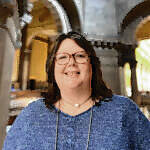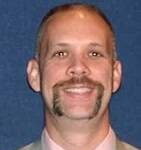By Harry McCawley
Vice President Mike Pence and the late J. Irwin Miller are arguably two of the most influential individuals that have called Columbus home.
That influence — either on their community in one instance or by it in another — is at the heart of two projects currently in development.
There’s a certain irony in the subject matter of the two projects.
One involves a figure that should have been president according to one national publication and the other involves one who very well could be president according to a number of his conservative supporters.
Their stories as they relate to Columbus are being told in different formats. Miller, the former chairman of the then-named Cummins Engine Co. and an internationally recognized philanthropist who fostered the architecture movement in his hometown, is the subject of a television documentary being prepared for airing tonight on the PBS network affiliate WTIU. The program examines the influence he had on converting Columbus from a non-descript small Southern Indiana town to a showcase community that was once called the “Athens of the Prairie.”
The Pence story and its relation to Columbus will be told through a book commissioned by the Indiana University Press and written by veteran Hoosier journalist Andrea Neal. Unlike the Miller documentary which examines his influence on Columbus, a chapter in the Pence story focuses on how the city influenced him.
Ironically, Pence came of age in Columbus during a period in which the community, driven in great part by Miller’s influence, was just beginning to transform itself.
I don’t think there’s any question as to Miller’s influence in the development of Columbus.
I’m not sure what the answer would be to the question, “What would Mike Pence be had he grown up someplace other than Columbus?”
For me, the two questions came together over the past week in conversations related to the upcoming book about Pence and the documentary about Miller.
Although there’s a lot that separates the two men – age, political leanings and family backgrounds among them – they are entwined by the community one helped to develop and in which the other came of age.
Actually, Pence grew up in two versions of Columbus. He was born in 1959, a period in which the town bore markings very similar to its other Indiana neighboring communities. Its population was basically white, a demographic often reflected in community attitudes. Black families, for instance often encountered difficulties in finding housing in the city because landlords refused to rent to them. A number of restaurants refused to serve people of color and many blacks had to travel out of town simply to get a haircut.
The town itself bore a worn-down look. Many of the 19th century buildings in the downtown area reflected their age through long periods of neglect. Much of a two-block area in the center of the downtown, which would eventually be transformed into an enclosed shopping mall and community center, was in the 1950s an unseemly clutter of bars and abandoned storefronts.
Educational facilities were in a similar condition. So-called new schools erected after World War II were actually a collection of prefabricated structures built on the cheap.
While that might have been Columbus at the time of Pence’s birth, it was also a town on the verge of dramatic change that would take place as he grew into a young man. Miller was at the center of that change.
Make no mistake, he was not the only catalyst in this period of transformation. Miller was joined by several other community leaders – chief among them the Rev. William Laws of Columbus’ First Presbyterian Church – in tearing down the racial barriers in Columbus that had long existed for black families. In some respects, such as the equal housing movement, Miller took a hard line, at one point telling landlords reluctant to rent to back families that their names would be removed from lists provided by Cummins Engine Co. to new employees unless they changed their practices.
Pence’s early years were also marked by a physical transformation of his downtown. The dilapidated two-block area in the downtown was converted into The Commons. It was a move that initially ran into a great deal of opposition from residents who argued that the historic character of the downtown was being sacrificed to the wrecking ball.
Ironically, that was the same attitude that was demonstrated more than 30 years later when the original Commons was essentially demolished in favor of a more modern and efficient structure. Voices in opposition to the restructuring project spoke to the importance of the original building in their own lives.
As Pence evolved through elementary, junior and high schools, the community went on a building spree, fueled in large part by the architecture program fostered by Miller that paid for the architectural fees of public buildings. Many of the schools that were built during Pence’s youth were part of this architectural program.
The Columbus into which Mike Pence was born, the one in which he grew up and the one that continued to evolve as he climbed the political ladder, which led to his present position as vice president of the United States, were developed in large part by the visions of J. Irwin Miller and a number of other community leaders.
I think that only Pence can answer the question as to whether one or all of those towns had a telling influence on his life.
[sc:pullout-title pullout-title=”Check it out” ][sc:pullout-text-begin]
The influence of the late J. Irwin Miller on the development of Columbus will be examined in a segment of the WTIU-TV program “The Weekly Special” which airs at 8 p.m. today.
The program will be available on the PBS station on the Indiana University campus in Bloomington and also can be accessed online.
It will also be paired with another segment concerning Bartholomew County — the development of the Utopia Wildlife Center.
[sc:pullout-text-end]
Harry McCawley is the former associate editor of The Republic. He can be reached at [email protected]. Send comments to [email protected].




